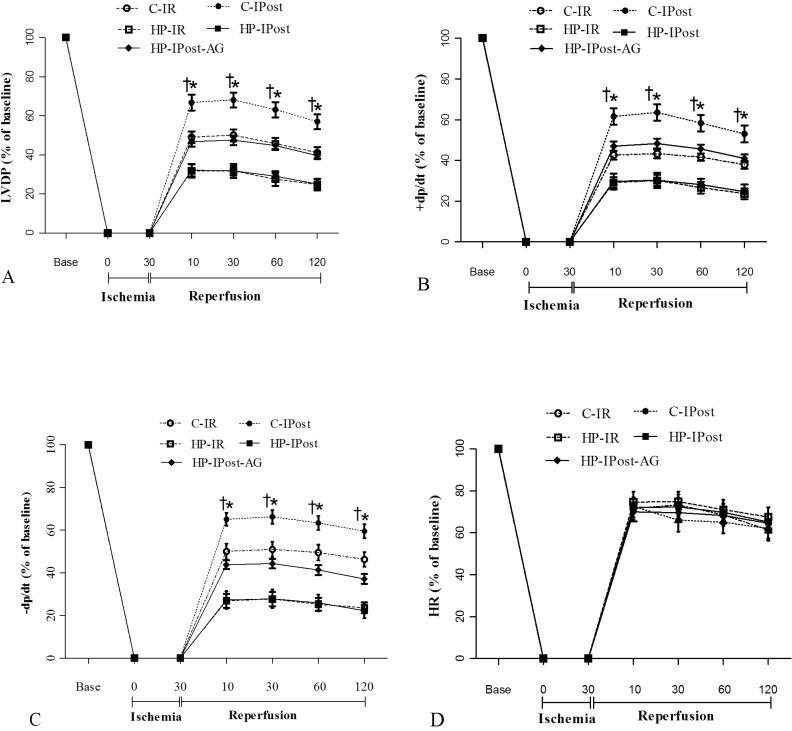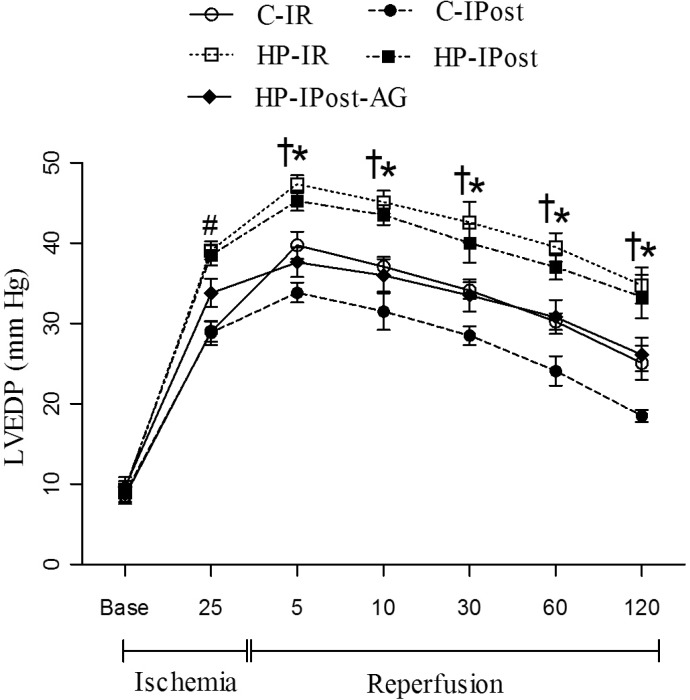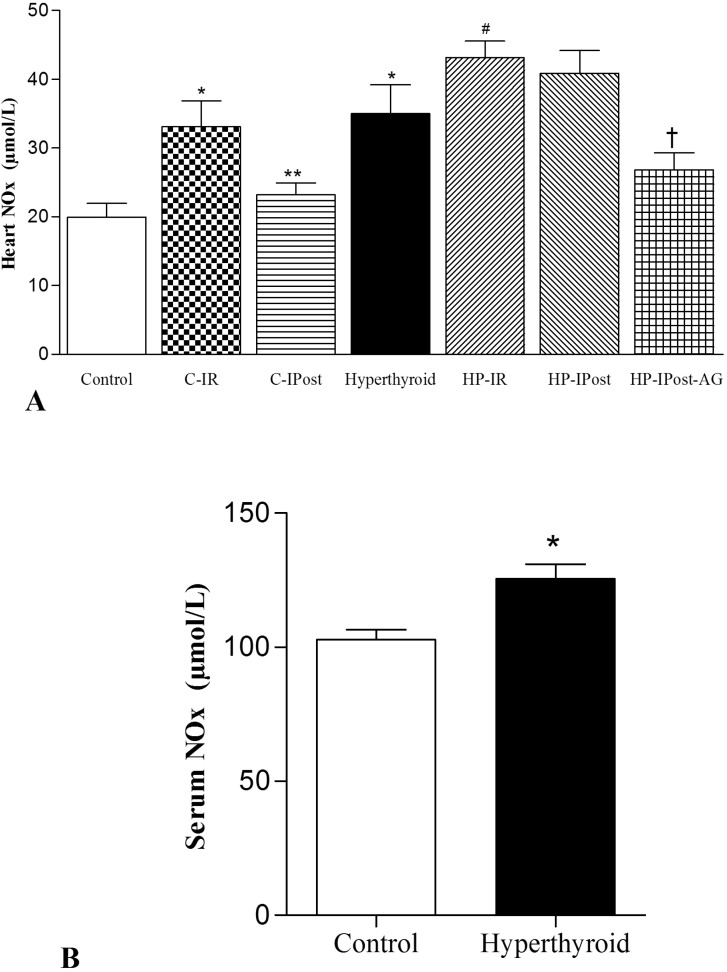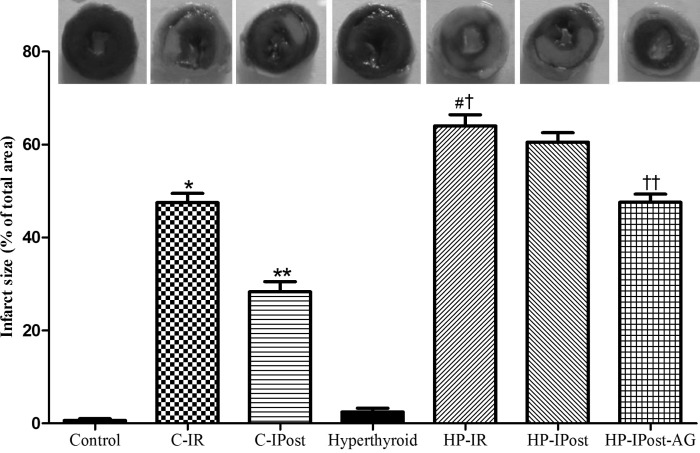Korean J Physiol Pharmacol.
2014 Dec;18(6):481-487. 10.4196/kjpp.2014.18.6.481.
The Effects of Ischemic Postconditioning on Myocardial Function and Nitric Oxide Metabolites Following Ischemia-Reperfusion in Hyperthyroid Rats
- Affiliations
-
- 1Endocrine Physiology Research Center, Research Institute for Endocrine Sciences, Shahid Beheshti University of Medical Sciences, Tehran 19395-4763, Iran. Ghasemi@endocrine.ac.ir
- 2Endocrine Research Center, Research Institute for Endocrine Sciences, Shahid Beheshti University of Medical Sciences, Tehran 19395-4763, Iran.
- KMID: 2285550
- DOI: http://doi.org/10.4196/kjpp.2014.18.6.481
Abstract
- Ischemic postconditioning (IPost) could decrease ischemia-reperfusion (IR) injury. It has not yet reported whether IPost is useful when ischemic heart disease is accompanied with co-morbidities like hyperthyroidism. The aim of this study was to examine the effect of IPost on myocardial IR injury in hyperthyroid male rats. Hyperthyroidism was induced with administration of thyroxine in drinking water (12 mg/L) over a period of 21 days. After thoracotomy, the hearts of control and hyperthyroid rats were perfused in the Langendorff apparatus and subjected to 30 minutes global ischemia, followed by 120 minutes reperfusion; IPost, intermittent early reperfusion, was induced instantly following ischemia. In control rats, IPost significantly improved the left ventricular developed pressure (LVDP) and +/-dp/dt during reperfusion (p<0.05); however it had no effect in hyperthyroid rats. In addition, hyperthyroidism significantly increased basal NOx (nitrate+nitrite) content in serum (125.5+/-5.4 micromol/L vs. 102.8+/-3.7 micromol/L; p< 0.05) and heart (34.9+/-4.1 micromol/L vs. 19.9+/-1.94 micromol/L; p<0.05). In hyperthyroid groups, heart NOx concentration significantly increased after IR and IPost, whereas in the control groups, heart NOx were significantly higher after IR and lower after IPost (p< 0.05). IPost reduced infarct size (p<0.05) only in control groups. In hyperthyroid group subjected to IPost, aminoguanidine, an inducible nitric oxide (NO) inhibitor, significantly reduced both the infarct size and heart NOx concentrations. In conclusion, unlike normal rats, IPost cycles following reperfusion does not provide cardioprotection against IR injury in hyperthyroid rats; an effect that may be due to NO overproduction because it is restored by iNOS inhibition.
Keyword
MeSH Terms
Figure
Reference
-
1. Peart JN, Headrick JP. Clinical cardioprotection and the value of conditioning responses. Am J Physiol Heart Circ Physiol. 2009; 296:H1705–H1720. PMID: 19363132.
Article2. Ferdinandy P, Schulz R, Baxter GF. Interaction of cardiovascular risk factors with myocardial ischemia/reperfusion injury, preconditioning, and postconditioning. Pharmacol Rev. 2007; 59:418–458. PMID: 18048761.
Article3. Monassier JP. Reperfusion injury in acute myocardial infarction. From bench to cath lab. Part I: Basic considerations. Arch Cardiovasc Dis. 2008; 101:491–500. PMID: 18848692.
Article4. de Groot H, Rauen U. Ischemia-reperfusion injury: processes in pathogenetic networks: a review. Transplant Proc. 2007; 39:481–484. PMID: 17362763.
Article5. Rastaldo R, Pagliaro P, Cappello S, Penna C, Mancardi D, Westerhof N, Losano G. Nitric oxide and cardiac function. Life Sci. 2007; 81:779–793. PMID: 17707439.
Article6. Xia A, Xue Z, Wang W, Zhang T, Wei T, Sha X, Ding Y, Zhou W. Naloxone Postconditioning Alleviates Rat Myocardial Ischemia Reperfusion Injury by Inhibiting JNK Activity. Korean J Physiol Pharmacol. 2014; 18:67–72. PMID: 24634599.
Article7. Zhao ZQ, Corvera JS, Halkos ME, Kerendi F, Wang NP, Guyton RA, Vinten-Johansen J. Inhibition of myocardial injury by ischemic postconditioning during reperfusion: comparison with ischemic preconditioning. Am J Physiol Heart Circ Physiol. 2003; 285:H579–H588. PMID: 12860564.
Article8. Paillard M, Gomez L, Augeul L, Loufouat J, Lesnefsky EJ, Ovize M. Postconditioning inhibits mPTP opening independent of oxidative phosphorylation and membrane potential. J Mol Cell Cardiol. 2009; 46:902–909. PMID: 19254723.
Article9. Chiari PC, Bienengraeber MW, Pagel PS, Krolikowski JG, Kersten JR, Warltier DC. Isoflurane protects against myocardial infarction during early reperfusion by activation of phosphatidylinositol-3-kinase signal transduction: evidence for anesthetic-induced postconditioning in rabbits. Anesthesiology. 2005; 102:102–109. PMID: 15618793.
Article10. Staat P, Rioufol G, Piot C, Cottin Y, Cung TT, L'Huillier I, Aupetit JF, Bonnefoy E, Finet G, André-Fouët X, Ovize M. Postconditioning the human heart. Circulation. 2005; 112:2143–2148. PMID: 16186417.
Article11. Mourouzis I, Dimopoulos A, Saranteas T, Tsinarakis N, Livadarou E, Spanou D, Kokkinos AD, Xinaris C, Pantos C, Cokkinos DV. Ischemic preconditioning fails to confer additional protection against ischemia-reperfusion injury in the hypothyroid rat heart. Physiol Res. 2009; 58:29–38. PMID: 18198989.
Article13. Pavón N, Aranda A, García N, Hernández-Esquivel L, Chávez E. In hyperthyroid rats octylguanidine protects the heart from reperfusion damage. Endocrine. 2009; 35:158–165. PMID: 19169849.
Article14. Venditti P, De Rosa R, Cigliano L, Agnisola C, Di Meo S. Role of nitric oxide in the functional response to ischemia-reperfusion of heart mitochondria from hyperthyroid rats. Cell Mol Life Sci. 2004; 61:2244–2252. PMID: 15338054.
Article15. Venditti P, Masullo P, Agnisola C, Di Meo S. Effect of vitamin E on the response to ischemia-reperfusion of Langendorff heart preparations from hyperthyroid rats. Life Sci. 2000; 66:697–708. PMID: 10680578.
Article16. Squadrito GL, Pryor WA. Oxidative chemistry of nitric oxide: the roles of superoxide, peroxynitrite, and carbon dioxide. Free Radic Biol Med. 1998; 25:392–403. PMID: 9741578.
Article17. Ashida K, Katsura T, Saito H, Inui K. Decreased activity and expression of intestinal oligopeptide transporter PEPT1 in rats with hyperthyroidism in vivo. Pharm Res. 2004; 21:969–975. PMID: 15212161.
Article18. Siu PM, Donley DA, Bryner RW, Alway SE. Citrate synthase expression and enzyme activity after endurance training in cardiac and skeletal muscles. J Appl Physiol (1985). 2003; 94:555–560. PMID: 12531911.19. Belaidi E, Beguin PC, Levy P, Ribuot C, Godin-Ribuot D. Delayed myocardial preconditioning induced by cobalt chloride in the rat: HIF-1α and iNOS involvement. Fundam Clin Pharmacol. 2012; 26:454–462. PMID: 21480981.
Article20. Miranda KM, Espey MG, Wink DA. A rapid, simple spectrophotometric method for simultaneous detection of nitrate and nitrite. Nitric Oxide. 2001; 5:62–71. PMID: 11178938.
Article21. Soni HM, Jain MR, Mehta AA. Mechanism(s) Involved in Carbon Monoxide-releasing Molecule-2-mediated Cardioprotection During Ischaemia-reperfusion Injury in Isolated Rat Heart. Indian J Pharm Sci. 2012; 74:281–291. PMID: 23626383.
Article22. Shackebaei D, Asadmobini A, Hesari M, Vaezi M, Shahidi S. Cardioprotective eff ect of diazepam on ischemia-reperfused isolated hyperthyroid rat heart. Turk J Biol. 2012; 36:598–605.23. Pantos C, Malliopoulou V, Varonos DD, Cokkinos DV. Thyroid hormone and phenotypes of cardioprotection. Basic Res Cardiol. 2004; 99:101–120. PMID: 14963669.
Article24. Pantos C, Malliopoulou V, Mourouzis I, Thempeyioti A, Paizis I, Dimopoulos A, Saranteas T, Xinaris C, Cokkinos DV. Hyperthyroid hearts display a phenotype of cardioprotection against ischemic stress: a possible involvement of heat shock protein 70. Horm Metab Res. 2006; 38:308–313. PMID: 16718626.
Article25. Kreuzberg U, Theissen P, Schicha H, Schröder F, Mehlhorn U, de Vivie ER, Bokník P, Neumann J, Grohé C, Herzig S. Single-channel activity and expression of atrial L-type Ca2+ channels in patients with latent hyperthyroidism. Am J Physiol Heart Circ Physiol. 2000; 278:H723–H730. PMID: 10710339.26. Arruda AP, Da-Silva WS, Carvalho DP, De Meis L. Hyperthyroidism increases the uncoupled ATPase activity and heat production by the sarcoplasmic reticulum Ca2+-ATPase. Biochem J. 2003; 375:753–760. PMID: 12887329.27. Kiss E, Jakab G, Kranias EG, Edes I. Thyroid hormone-induced alterations in phospholamban protein expression. Regulatory effects on sarcoplasmic reticulum Ca2+ transport and myocardial relaxation. Circ Res. 1994; 75:245–251. PMID: 8033338.28. Segal J, Masalha S, Schwalb H, Merin G, Borman JB, Uretzky G. Acute effect of thyroid hormone in the rat heart: role of calcium. J Endocrinol. 1996; 149:73–80. PMID: 8676057.
Article29. Venditti P, Agnisola C, Di Meo S. Effect of ischemia-reperfusion on heart mitochondria from hyperthyroid rats. Cardiovasc Res. 2002; 56:76–85. PMID: 12237168.
Article30. Masullo P, Venditti P, Agnisola C, Di Meo S. Role of nitric oxide in the reperfusion induced injury in hyperthyroid rat hearts. Free Radic Res. 2000; 32:411–421. PMID: 10766409.
Article31. Juhaszova M, Zorov DB, Yaniv Y, Nuss HB, Wang S, Sollott SJ. Role of glycogen synthase kinase-3beta in cardioprotection. Circ Res. 2009; 104:1240–1252. PMID: 19498210.32. Kalderon B, Hermesh O, Bar-Tana J. Mitochondrial permeability transition is induced by in vivo thyroid hormone treatment. Endocrinology. 1995; 136:3552–3556. PMID: 7628392.
Article33. Yin X, Zheng Y, Zhai X, Zhao X, Cai L. Diabetic inhibition of preconditioning- and postconditioning-mediated myocardial protection against ischemia/reperfusion injury. Exp Diabetes Res. 2012; 2012:198048. PMID: 21822424.
Article34. Badalzadeh R, Mohammadi M, Najafi M, Ahmadiasl N, Farajnia S, Ebrahimi H. The additive effects of ischemic postconditioning and cyclosporine-A on nitric oxide activity and functions of diabetic myocardium injured by ischemia/reperfusion. J Cardiovasc Pharmacol Ther. 2012; 17:181–189. PMID: 21828282.
Article35. Wagner C, Kloeting I, Strasser RH, Weinbrenner C. Cardioprotection by postconditioning is lost in WOKW rats with metabolic syndrome: role of glycogen synthase kinase 3beta. J Cardiovasc Pharmacol. 2008; 52:430–437. PMID: 19033822.36. Przyklenk K, Maynard M, Greiner DL, Whittaker P. Cardioprotection with postconditioning: loss of efficacy in murine models of type-2 and type-1 diabetes. Antioxid Redox Signal. 2011; 14:781–790. PMID: 20578962.
Article37. Rodríguez-Gómez I, Wangensteen R, Moreno JM, Chamorro V, Osuna A, Vargas F. Effects of chronic inhibition of inducible nitric oxide synthase in hyperthyroid rats. Am J Physiol Endocrinol Metab. 2005; 288:E1252–E1257. PMID: 15644461.
Article38. Oztay F, Ergin B, Ustunova S, Balci H, Kapucu A, Caner M, Demirci C. Effects of coenzyme Q10 on the heart ultrastructure and nitric oxide synthase during hyperthyroidism. Chin J Physiol. 2007; 50:217–224. PMID: 18274157.39. Kuzman JA, Vogelsang KA, Thomas TA, Gerdes AM. L-Thyroxine activates Akt signaling in the heart. J Mol Cell Cardiol. 2005; 39:251–258. PMID: 15890358.40. Araujo AS, Schenkel P, Enzveiler AT, Fernandes TR, Partata WA, Llesuy S, Ribeiro MF, Khaper N, Singal PK, Belló-Klein A. The role of redox signaling in cardiac hypertrophy induced by experimental hyperthyroidism. J Mol Endocrinol. 2008; 41:423–430. PMID: 18787053.
Article41. Fan Q, Yang XC, Liu Y, Wang LF, Liu SH, Ge YG, Chen ML, Wang W, Zhang LK, Irwin MG, Xia Z. Postconditioning attenuates myocardial injury by reducing nitro-oxidative stress in vivo in rats and in humans. Clin Sci (Lond). 2011; 120:251–261. PMID: 20919993.
Article42. Ferdinandy P, Schulz R. Nitric oxide, superoxide, and peroxynitrite in myocardial ischaemia-reperfusion injury and preconditioning. Br J Pharmacol. 2003; 138:532–543. PMID: 12598407.
Article43. Gao Q, Hu JF, Yu Y, Jiang CR, Guan SD, Li ZH. The role of nitric oxide in ethanol postconditioning induced cardioprotection. Zhongguo Ying Yong Sheng Li Xue Za Zhi. 2012; 28:9–13. PMID: 22493883.44. Csonka C, Szilvássy Z, Fülöp F, Páli T, Blasig IE, Tosaki A, Schulz R, Ferdinandy P. Classic preconditioning decreases the harmful accumulation of nitric oxide during ischemia and reperfusion in rat hearts. Circulation. 1999; 100:2260–2266. PMID: 10578001.
Article
- Full Text Links
- Actions
-
Cited
- CITED
-
- Close
- Share
- Similar articles
-
- Mechanism of Ischemia and Reperfusion Injury to the Heart: From the Viewpoint of Nitric Oxide and Mitochondria
- Effects of Remote Ischemic Conditioning Methods on Ischemia-Reperfusion Injury in Muscle Flaps: An Experimental Study in Rats
- Ischemic postconditioning may not influence early brain injury induced by focal cerebral ischemia/reperfusion in rats
- Effects of Ischemic preconditioning on the Post-ischemic Myocardial Dysfunction and Coronary Flow in the Isolated Rat Hearts
- Protective mechanism of nitric oxide and mucus against ischemia/reperfusion-induced gastric mucosal injury





